Strategic Path: Creating Seamless User Experiences

Today, I had the pleasure of moderating a panel at the Future of Integration Summit at Marina Bay Sands titled "Designing for Flexibility: Creating Seamless User Experiences in the Agile Workplace."
I was joined by two experts who view the workplace from very different yet complementary lenses: Carol Wong, Managing Director at Cushman & Wakefield who handles the strategic and human side, and Jeremy Liao, Workplace Technology Consultant at PTS Consulting, who translates that strategy into technical reality.
We opened the discussion with a hard truth. For decades, the AV industry has been a source of friction. Bad remotes, missing cables, and hostile "agile" spaces. But we have reached an inflection point.

As I told the audience, the best AV experience is the one you don't notice. The ultimate goal is invisible AV. Here are the key takeaways from our discussion on how to achieve it.
1. The New KPI: "Can I Go Home an Hour Early?"
When I asked the panel to define a seamless experience, Carol Wong didn't talk about uptime or resolution. She gave a very human metric. "Seamless means I can go home one hour earlier," she said. If the technology works, the employee is productive, the friction is gone, and they get their time back.
Jeremy Liao echoed this. He compared the meeting room experience to getting ready in the morning. You have a routine. If your toothbrush isn't where it should be, your whole morning is thrown off. When users have to come to a meeting 10 minutes early just to "ensure we get the tech sorted," as Carol noted, we have failed. The technology must be an invisible enabler, not a hurdle to clear.
2. Design for Modularity (The Layered Approach)
How do we design infrastructure that doesn't become obsolete in two years? Jeremy offered a brilliant analogy. Think of your AV system like a car. When you have a flat tire, you don't pull out the entire engine, Jeremy explained. You just swap the tire. We need to design systems with modularity and layering.
When a new camera technology or a higher resolution screen comes along, you should be able to swap that specific component without revamping the entire ecosystem. This "layered" approach is the only way to maintain flexibility in a world where technology moves at breakneck speed.
3. Inclusivity is Non-Negotiable
A seamless audio-visual or collaboration system isn't seamless if it only works for the boss. I shared a personal story about a previous office design where the interactive touch panels were mounted at my height (1.85m) because the design team wanted to please the President of the APAC region. I told them to lower it. I am not the main user. The office is for everyone.
Jeremy emphasized that universal design shouldn't discriminate. Whether it's mounting heights or interface complexity, the experience must be consistent for every user, regardless of their physical ability or tech-savviness.

4. AI as the Invisible Concierge
We discussed the role of AI but not in the way you might expect. It's not just about generative text. It is about hospitality. Carol envisions a workplace where the room knows you are coming, just like a smart coffee machine knows you take it black. Jeremy sees a future where lighting and temperature adjust automatically before you even step in.
From my perspective, the immediate win for AI is operational. AI should be the invisible force that realizes you're in a Microsoft Teams Room but have a Zoom link, and automatically prompts a BYOM session using a USB-C cable connected to your laptop. It should be the tool that predicts friction or failure and reboots the system at 3:00 AM, so the room is ready at 8:00 AM before employees come in.
5. The Middle Management Resistance
During our Q&A, a crucial insight emerged regarding change management. Carol noted that in almost every transformation project, the highest resistance doesn't come from the C-Suite or the junior staff. It comes from Middle Management. They are the ones squeezed between new strategic directives and daily operational reality. To design a truly flexible workplace, we cannot just install technology. We must equip middle managers with the narratives and tools to lead their teams through the change.
6. The Office Must Be a Destination
I closed the session with a thought on the "Return to Office." We cannot force people back. We have to realize that many employees now have a better AV setup at home. Good webcams, clear audio, focus time. They often have a better experience than they do in the office meeting room. Therefore, why would they commute an hour for a lesser experience?
We must make the office a destination. It must be a social place where technology works better, faster, and more seamlessly than it does at home. If we can do that, if we can make the AV invisible and the experience frictionless, we aren't just selling technology. We are giving people their time back.
Conclusion
Ultimately, "Designing for Flexibility" is not about adding more features; it is about removing barriers. It is about trusting that the best technology is the kind that gets out of the way so human connection can take center stage.
As we look toward the future of integration, our mandate is clear: We must stop designing for the room and start designing for the human. When we do that, we don't just build better offices, we build better ways of working.
I'd love to hear from you: What is the biggest "friction point" in your current meeting room setup that stops you from "going home an hour earlier"? Let me know in the comments.
-
Xchange Advocates are recognized AV/IT industry thought leaders and influencers. We invite you to connect with them and follow their activity across the community as they offer valuable insights and expertise while advocating for and building awareness of the AV industry.






Please sign in or register for FREE
If you are a registered user on AVIXA Xchange, please sign in